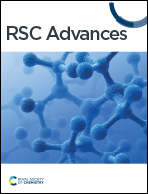Biogenic silver nanoparticles' antibacterial activity and cytotoxicity on human hepatocarcinoma cells (Huh-7)†
Abstract
Exploring diverse synthetic pathways for nanomaterial synthesis has emerged as a promising direction. For example, silver nanoparticles (AgNPs) are synthesized using different approaches yielding nanomaterials with distinct morphological, physical and biological properties. Hence, the present study reports the biogenic synthesis of silver nanoparticles using the aqueous secretome of the fungus Fusarium oxysporum f. sp. cubense (AgNP@Fo) and orange peel extract (AgNP@OR). The physical and morphological properties of synthesized nanoparticles were similar, with AgNP@Fo measuring 56.43 ± 19.18 nm and AgNP@OR measuring 39.97 ± 19.72 nm in size. The zeta potentials for the nanoparticles were low, −26.8 ± 7.55 and −26.2 ± 2.87 mV for AgNP@Fo and AgNP@OR, respectively, demonstrating a similar negative charge. The spherical morphologies of both nanoparticles were evidenced by Scanning Transmission Electron Microscopy (STEM) and Atomic Force Microscopy (AFM). However, despite their similar physical and morphological properties, AgNPs demonstrated different bioactivities. We evaluated and compared the antimicrobial efficacy of these nanoparticles against a range of bacteria, such as Staphylococcus aureus, Enterococcus faecalis, Pseudomonas aeruginosa, and Escherichia coli. The AgNP@Fo showed Minimum Inhibitory Concentration (MIC) values ranging from 0.84 to 1.68 μg mL−1 and were around ten times more potent compared to AgNP@OR. The anticancer activities of both nanoparticles were investigated using human hepatocarcinoma cells (Huh-7), where AgNP@Fo exhibited around 20 times higher cytotoxicity than AgNP@OR with an IC50 value of 0.545 μmol L−1. Anticancer effects were demonstrated by the MTT, confirmed by the calcein-AM assay and fluorescence imaging. This study establishes solid groundwork for future exploration of molecular interactions of nanoparticles synthesized through distinct biosynthetic routes, particularly within bacterial and cancerous cell environments.

- This article is part of the themed collection: Celebrating Latin American Chemistry


 Please wait while we load your content...
Please wait while we load your content...